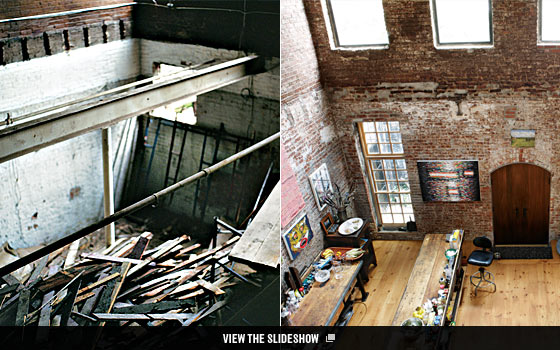
It was such a massive undertaking it could have been a reality show. Scarcely had the artists Dustin Yellin and Charlotte Kidd moved to Red Hook three years ago when they fell so in love with the hood that they started looking for something big, for a way to build a mixed-use bohemian dream house—with studios, gallery, and plenty of flexible living space.
“It feels like a small town,” explains Yellin, who plays the sincere, romantic hippie (raised by his lesbian mother in California and Colorado, before she decamped to Hawaii) to Kidd’s dry, detached, born-and-bred New Yorker. “And On the Waterfront was filmed right over there!”
They found something big: a decrepit nineteenth-century brick building with two large wings added in the fifties. Used mainly for storage, it wasn’t for sale. But they tracked down the owner and cajoled him into parting ways with the place. They were then the proud owners of 15,000 square feet of really raw industrial space.
Make that semi-proud.
“It was disgusting,” recalls Kidd. “It was a mix between a crack den and an abandoned garage. We filled six Dumpsters before we could even get started.”
After two years of work—much of which they did themselves—the complex was finally done. One wing, presided over by a lone relic of the old space, a 1929 printing press, was made into a large white gallery space, where the couple show works of friends. It also contains a small, spruce apartment. The other wing was made into a mammoth studio for Yellin to make and show his ethereal sculptures, which sandwich layers of paint and resin to create monoliths that appear both futuristic and Victorian (like holograms trapped in amber).
The central building was fashioned into living quarters for the couple and the two German-shepherd-mix dogs (which they’ve named Israel and Palestine) who turned up at their door a year ago. Upstairs is a master suite and downstairs a workspace for Kidd, whose most recent project was photographing truckers lying in the beds of their cabs.
Surveying the scene now, one has to strain to imagine the tumultuous process of transformation. But if a reality-show producer thinks he missed the boat, fear not: The real show has just begun. Front and center in Yellin’s studio is easily the most striking object in the place: a massive, aluminum 1952 Airstream trailer. It was his dream, and now it’s his reality: For the past few weeks, he and Kidd have been on a break and he has been exiled to the Airstream.
“But somehow he’s there naked in my sauna every morning,” gripes Kidd.
“My steam room,” corrects Yellin.
And when asked to name other artists they’re friends with in the neighborhood, Kidd soon offers up this plum.
“Your girlfriend,” she says to Yellin.
“Don’t mention that, please,” he says quietly.
“No?” she says. “Why not?
“Because you know why not. We’re not mentioning her.”
“What? She’s a friend—a mutual friend.”
And so on. It’s a rather charming reminder that even on this bleak industrial byway, in a curiously atypical abode that morphs from gallery to studio to living room, human nature reasserts itself in the most familiar ways.
It may be a 1952 Airstream trailer, but right now, it’s the doghouse.
“Aren’t you glad I’m leaving tomorrow?” Kidd asks.
“Yes,” says Yellin.

Main room, before. Photo: Charlotte Kidd

Yellin’s studio, before. Photo: Charlotte Kidd

Yellin’s Studio
Yellin’s dream for his huge open studio space was an old Airstream trailer/furniture/sculpture/guest bedroom in one”and he found and restored this beauty. Sleeps two, occasionally.
Photo: Hannah Whitaker

Master suite, before Photo: Charlotte Kidd

Master Suite
Tons of stuff (and a squatter or two) had to be removed from the premises before the real renovation could begin.
Photo: Hannah Whitaker
